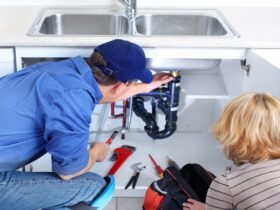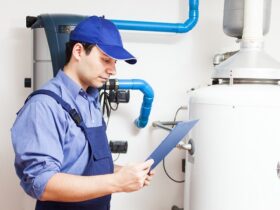After twenty years in the plumbing trade, I’ve heard just about every home remedy, old wives’ tale, and questionable DIY tip you can imagine. Some make me chuckle, others make me cringe, and a few have actually cost homeowners thousands of dollars in unnecessary repairs.
The thing about plumbing myths is that they spread like wildfire. Someone tries a “trick” they heard from their neighbor, it seems to work temporarily, and before you know it, half the neighborhood thinks they’ve discovered some secret the plumbers don’t want you to know. Trust me, we’re not hiding anything—we just want your pipes to work properly without causing expensive damage down the line.
Today, I want to set the record straight on some of the most persistent plumbing myths I encounter in my daily work. Some of these misconceptions are harmless, but others can lead to serious problems that end up costing far more than calling a professional in the first place.
Myth: A Dripping Faucet Is Just a Minor Annoyance
I can’t tell you how many service calls I’ve been on where homeowners apologetically mention “that little drip in the kitchen” as if it’s barely worth mentioning. They’re often shocked when I explain that a single dripping faucet can waste hundreds of gallons of water over the course of a year.
Beyond the water waste, that constant drip is usually a sign of a worn washer, O-ring, or valve seat. Left unaddressed, these small components can deteriorate further, leading to more significant leaks that can cause water damage to cabinets, floors, or even the structure below.
I’ve seen kitchen cabinets completely ruined because homeowners ignored a “harmless” drip for months. The constant moisture creates perfect conditions for mold and wood rot. What could have been a simple washer replacement becomes a major renovation project.
The fix is usually straightforward and inexpensive, especially if you catch it early. Don’t let that annoying drip turn into a major headache.
Myth: You Can Put Anything Down the Garbage Disposal
This myth has probably generated more service calls for me than any other. Homeowners seem to think garbage disposals are magical devices that can handle anything you throw at them. I’ve pulled out everything from chicken bones and corn husks to grease and coffee grounds.
Here’s the reality: garbage disposals are designed to handle soft food scraps, not everything that comes out of your kitchen. Grease and oil solidify in your pipes and create blockages. Fibrous foods like celery and onion skins wrap around the blades. Hard items like bones and fruit pits can damage the motor or jam the mechanism.
Coffee grounds are particularly troublesome. They don’t break down in water and instead accumulate in your pipes like sludge. I’ve snaked out pipes that looked like they were filled with wet cement, and it was all coffee grounds.
The worst case I remember was a customer who regularly put pasta down their disposal. Pasta continues to expand when it’s wet, and over time, it created a massive blockage that required professional equipment to clear.
Stick to soft food scraps in small quantities, run plenty of cold water, and your disposal will serve you well for years.
Myth: Chemical Drain Cleaners Are the Best Solution for Clogs
Walk down any hardware store aisle and you’ll see shelves lined with chemical drain cleaners promising to dissolve any clog. What the labels don’t tell you is that these chemicals can cause more problems than they solve.
Most commercial drain cleaners work by generating heat through chemical reactions. While this can sometimes dissolve clogs, it can also damage your pipes, especially if you have older galvanised steel or PVC pipes. I’ve seen pipes that were literally eaten away by repeated use of harsh chemicals.
These chemicals are also dangerous to work with. If a chemical drain cleaner doesn’t clear your clog and you call a plumber, we’re now dealing with caustic chemicals in standing water. This creates safety hazards and often requires special procedures to neutralize the chemicals before we can work. It’s better to take help from a blocked drain plumber in this case.
The other problem is that chemical drain cleaners often provide only temporary relief. They might burn through part of a clog, but they don’t address the underlying cause. The clog often returns, sometimes worse than before.
A simple plunger or drain snake is usually more effective and much safer for your pipes. If those don’t work, it’s time to call a professional rather than reach for harsh chemicals.
Myth: Running Water While Using the Garbage Disposal Prevents Clogs
This myth isn’t entirely wrong, but it’s incomplete and gives people a false sense of security. Yes, you should run water when using your garbage disposal—cold water specifically—but running water doesn’t prevent all clogs, especially if you’re putting the wrong things down the disposal in the first place.
Cold water helps solidify any grease so it can be chopped up and flushed away, rather than coating your pipes. Hot water actually makes grease problems worse by melting the grease, which then re-solidifies further down your pipes where you can’t reach it.
However, running water won’t help if you’re putting fibrous materials, large quantities of food, or inappropriate items down the disposal. The water just carries the problem further into your plumbing system, often making it harder and more expensive to fix.
I always tell customers that the garbage disposal should be used sparingly and only for small, soft food scraps. Think of it as a way to catch the bits that inevitably go down the drain during normal dishwashing, not as a primary method of food disposal.
Myth: A Running Toilet Is Normal and Can Wait
I hear this one a lot: “Oh, that toilet in the guest bathroom runs sometimes, but if you jiggle the handle, it stops.” Homeowners often live with running toilets for months or even years, thinking it’s just one of those quirky things old houses do.
A running toilet is wasting water constantly, which shows up on your water bill every month. More importantly, it’s usually a sign that components inside the tank are wearing out. The most common culprits are the flapper, chain, or flush valve, all of which are inexpensive to replace.
If you ignore a running toilet long enough, the problem often gets worse. I’ve seen cases where a constantly running toilet caused the water level to drop so low that the seal at the base of the toilet dried out, leading to leaks that damaged the floor underneath.
The fix is usually simple and cheap, especially compared to repairing water damage or replacing a toilet that has shifted due to floor damage.
Myth: You Don’t Need to Worry About What Goes Down the Drain
This might be the most expensive myth on my list. I’ve met homeowners who treat their drains like garbage disposals, flushing everything from cat litter and feminine hygiene products to paint and cooking grease down toilets and sinks.
Your plumbing system is designed to handle human waste, toilet paper, and water. That’s it. Everything else is a potential problem waiting to happen. Flushing inappropriate items can cause clogs, but it can also damage your sewer line or cause problems at the water treatment facility.
Cat litter is particularly problematic because it’s designed to clump when wet. Even “flushable” litter can cause serious blockages. I’ve had to snake out sewer lines that were completely blocked with clumped litter.
Grease from cooking is another major culprit. When it cools in your pipes, it solidifies and catches other debris, creating massive blockages. The proper way to dispose of cooking grease is to let it solidify in a container and throw it in the trash.
Read this for drainage laws and rules by Qld gov.
Myth: All Plumbers Charge the Same, So Go With the Cheapest
I understand that plumbing repairs can be expensive, and it’s natural to want to save money. However, choosing a plumber based solely on price can end up costing you much more in the long run.
Quality plumbing work requires experience, proper tools, and quality parts. A plumber who gives you a quote that seems too good to be true might be cutting corners somewhere. They might use inferior parts, rush through the job, or lack the experience to identify underlying problems.
I’ve been called to fix botched repairs more times than I can count. Sometimes the original problem was simple, but poor workmanship turned it into a major issue requiring extensive repairs. What started as a budget-friendly fix becomes an expensive nightmare.
Look for plumbers who are licensed, insured, and have good references. Ask about warranties on their work. A slightly higher upfront cost for quality work can save you thousands in future repairs.
Myth: Plumbing Problems Always Have Obvious Signs
Many homeowners believe that plumbing problems announce themselves with dramatic leaks or complete blockages. In reality, many serious plumbing issues develop slowly and show subtle signs that are easy to miss or ignore.
Small leaks behind walls or under slabs can cause significant damage before they become visible. I’ve seen cases where homeowners noticed slightly higher water bills or occasional damp spots but didn’t think much of it until major damage had already occurred.
Tree root infiltration into sewer lines is another problem that develops gradually. You might notice that drains are a bit slower than usual or that you need to plunge toilets more frequently. These subtle signs often indicate that roots are growing into your sewer line, but many homeowners don’t make the connection until they have a complete backup.
Pay attention to changes in your plumbing system, even minor ones. Slightly slower drains, minor water pressure changes, or small increases in your water bill can all be early warning signs of larger problems.
Myth: DIY Plumbing Repairs Always Save Money
With all the information available online, more homeowners are attempting their own plumbing repairs. While I appreciate the DIY spirit, plumbing is one area where a small mistake can cause major damage.
I’ve seen homeowners flood their basements trying to replace a simple faucet because they didn’t know how to properly shut off the water supply. I’ve seen botched pipe repairs that resulted in water damage requiring thousands of dollars in restoration work.
Even seemingly simple jobs can have complications that aren’t obvious to someone without plumbing experience. What looks like a straightforward toilet installation might reveal problems with the floor, the drain flange, or the water supply that require professional attention.
Basic maintenance tasks like unclogging drains or replacing toilet flappers are usually fine for DIY enthusiasts. However, anything involving cutting pipes, moving fixtures, or working with gas lines should be left to professionals.
Myth: Water Heater Problems Are Always Obvious
Water heaters are workhorses that often fail gradually rather than catastrophically. Many homeowners don’t realize their water heater is having problems until they’re taking cold showers.
Signs that your water heater needs attention include water that takes longer to heat up, rusty or discolored hot water, unusual noises from the tank, or moisture around the base of the unit. These symptoms often develop slowly, so they’re easy to dismiss as normal aging.
I’ve seen water heaters that were leaking slowly for months before homeowners noticed. By then, the damage to surrounding floors or walls was significant. Regular inspection of your water heater can help catch problems early when they’re cheaper and easier to fix.
Most water heaters last between eight and twelve years with proper maintenance. If yours is approaching that age and showing any symptoms, it’s worth having it inspected before it fails completely.
The Truth About Preventive Maintenance
One of the biggest misconceptions I encounter is that plumbing systems don’t need regular maintenance. Homeowners often assume that as long as everything seems to be working, there’s nothing to worry about.
Regular maintenance can prevent most plumbing emergencies and extend the life of your plumbing system. Simple tasks like cleaning drain stoppers, checking for leaks, and testing water pressure can help identify problems before they become serious.
Having your main sewer line inspected periodically can reveal tree root infiltration or other issues before they cause backups. Flushing your water heater annually removes sediment buildup that can reduce efficiency and shorten its lifespan.
The small cost of preventive maintenance is nothing compared to the expense of emergency repairs or water damage restoration. Plus, well-maintained plumbing systems are more efficient and reliable.
Working With Professional Plumbers
After two decades in this business, I can tell you that the best customer relationships are built on honest communication and mutual respect. Don’t be embarrassed about plumbing problems or feel like you need to attempt repairs yourself before calling for help.
Good plumbers want to solve your problems efficiently and prevent future issues. We’re not trying to upsell you on unnecessary work, but we might recommend additional maintenance or repairs that will save you money in the long run.
Ask questions about the work being done and don’t hesitate to request explanations. A professional plumber should be happy to educate you about your plumbing system and help you understand how to maintain it properly.
Remember that emergency calls are always more expensive than scheduled service calls. If you have a minor problem that’s not causing immediate damage, scheduling a service appointment during regular business hours will usually save you money.
Understanding the truth behind these common plumbing myths can help you maintain your home’s plumbing system more effectively and avoid costly mistakes. When in doubt, don’t hesitate to consult with a professional—it’s almost always cheaper than fixing the consequences of well-intentioned but misguided DIY attempts.











Leave a Review